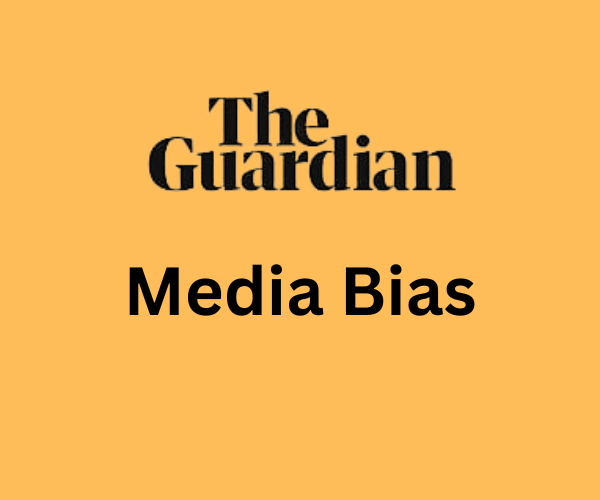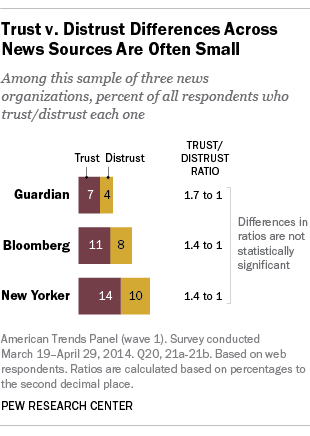
The Guardian, a prominent British daily newspaper, was founded in 1821 as The Manchester Guardian. It evolved from a local publication to an internationally recognized media outlet with a significant digital footprint. In this article, we will analyze the newspaper’s coverage and editorial decisions to determine if there is a discernible political bias in their reporting. Through our analysis, we hope to provide a comprehensive answer to whether the Guardian is biased and shed light on the factors contributing to media bias.
Despite declining print circulation, the Guardian’s influence extends far beyond its physical copies, with a wide-reaching online presence. In July 2021, the newspaper’s print edition had a daily circulation of about 105,134. On the other hand, its digital content reached millions in the U.K. and globally. According to the Pew Research Center, the Guardian’s ratios of trust over distrust are similar to other outlets like Bloomberg and The New Yorker.

Source: Pew Research Center
Known for its left-leaning orientation, the Guardian appeals predominantly to a liberal readership. Its journalism, marked by in-depth investigative reporting, has led to significant scoops like the News International phone-hacking scandal and the Edward Snowden leaks, reinforcing its reputation for quality and reliability.
How Does Biasly Rate News Sources?
Biasly’s algorithms produce bias ratings to help provide multiple perspectives on given articles. Biasly has analyzed 200,000+ news articles from more than 3,200 news sources through our A.I. technology and team of political analysts to find the most factual, unbiased news stories.
Biasly determines the degree of political bias in news sources by using Biasly’s Bias Meter Rating, in which Biasly’s team analyzes media sources’ reliability and bias and produces three scores, a Reliability Score that measures the accuracy of media sources; an A.I. Bias Score, evaluated by A.I.; and an Analyst Bias Score evaluated by political analysts. These scores are rated based on seven rating metrics including Tone, Tendency, Diction, Author Check, Selection/Omission, Expediency Bias, and Accuracy. These metrics help our analysts to determine the political attitude of the article.
Our A.I. machine-learning system employs natural language processing and entity-specific sentiment analysis to examine individual articles and determine their bias levels. By analyzing the key terms in an article such as policies, bias phrases, political terminologies, politicians, and their nicknames, the algorithms can rate the attitude of the text. Bias scores range from -100% and 100%, with higher negative scores being more liberal and higher positive scores being more conservative, and 0% being neutral.
Is the Guardian Politically Biased?
Biasly’s rating for the Guardian originates from two scores, one from its computer algorithms, based on A.I., and one from its analysts. The Guardian received a Computer and Analyst bias score of Moderately Liberal. We determine our Analyst scores from an average of at least 15 articles, each reviewed by one liberal, moderate, and conservative analyst. As Biasly rates more articles, the scores will become more accurate. Praise for liberal politicians and policies, as well as dislike toward Republican policies and politicians, contribute to this rating. Biasly’s scores closely align with determinations by other third-party bias research agencies.
The Guardian has faced challenges with comment moderation on their website. Editor-in-chief Kath Viner noted that topics such as Islam, refugees, and immigration often attracted hate speech and racism in comments. As a result, the newspaper tightened its commenting rules after finding that women and minority journalists were the most targeted for abuse. Deleted comments included personal attacks and complaints about the moderation of their “Comment is Free” section. David Shariatmadari, deputy editor of Comment is Free, and Laura Oliver, a community manager, emphasized the importance of managing conversations and encouraging two-way communication with readers. This situation highlights the complexities of moderating online discussions while maintaining respectful and constructive dialogue.
Readers like you are more likely to have a strong opinion of the Guardian based on your political leaning. The outlet tends to favor liberal causes and people, as represented by Biasly’s “Moderately Liberal” rating. In the remainder of this article, we will discuss ways to identify this bias so you can separate the opinions from the facts and become a more informed news consumer.
Before we begin, we need to discuss bias. Bias is a natural function of humans, and we can express it both consciously and unconsciously. Bias is one of the most fundamental forms of pattern recognition in humans. This isn’t to lower the bar and say that “all things are biased,” but to explain the process in which we may come to trust certain news organizations that display patterns of coverage.
On the media’s part, there is an incentive to retain audiences, encourage them to purchase subscriptions, and rate products positively. Bias is a two-way street, people want to see news stories about things they care about, and the media needs viewers to continue their operations. This creates a positive feedback loop that influences what stories are covered and from what perspective. This also explains the actions of more liberal news organizations.
Analysis of Bias in Guardian Online Articles
The most common metrics used when determining bias include tone, author, diction, tendency, and expediency bias. Tone refers to the attitude of the writing and is related to but distinct from diction, which is the writer’s word choices. The Author metric refers to the writer of the article and their demonstrated stance on issues through past articles and social media posts.
Moreover, tendency measures the consistency of an author’s tone or bias. A Center or neutral tendency indicates a balanced approach with no consistent bias. Somewhat Liberal/Conservative shows slight, occasional bias, though the author generally tries to remain neutral. A Very Liberal/Conservative tendency means the author often, but not always, leans towards a particular viewpoint. In an Extremely Liberal/Conservative scenario, the bias is evident throughout the article, favoring one side.
Finally, expediency bias relates to the initial impression from an article’s headline, images, or summary. A Center or neutral expediency bias presents information fairly without delay or misleading elements. Somewhat Liberal/Conservative indicates a slight favoritism in headlines and images. Very Liberal/Conservative expediency bias shows apparent favoritism for one viewpoint in the headline and pictures. Lastly, Extremely Liberal/Conservative expediency bias is when headlines and images blatantly favor one side, often resembling clickbait.

Source: The Guardian
For example, the headline of this opinion article in the Guardian, coupled with the image of Donald Trump enshrouded in darkness, suggests an element of expediency bias through its focus on immediate, emotionally charged issues. The inclusion of Trump’s image, a figure who commands significant attention, alongside a headline about “threats of vigilante justice” as an election looms, is designed to draw quick reader interest and engagement.
Moving forward, the first article by the Guardian we will examine is titled “Republican party of Florida ousts chairman over rape allegations.” Biasly has rated this article on the Bias Meter as “Moderately Liberal.” Part of the reason for this rating is its focus on Republican internal conflicts, the emphasis on controversies surrounding GOP figures, and the highlighting of policies affecting LGBTQ+ rights.
The article’s tone and tendency are critical and investigative, particularly towards the Republican party and its handling of serious allegations. It highlights pertinent internal conflicts and controversies, emphasizing the tension within the party. For example, according to the article:
“The party suspended Ziegler last month and demanded his resignation, saying he could not effectively lead during a critical election year with the allegations, which Ziegler denies, swirling around him.”
This quote acknowledges that the GOP denounces Ziegler but still centers on the challenges faced by Republicans and the effects of his allegations on the party’s leadership. Additionally, the article underscores the broader political implications of the scandal, particularly its timing with important electoral events. The critical tone exposes itself further through the discussion of policies affecting LGBTQ+ rights under Governor DeSantis:
“Beyond the rape accusation, there is another troublesome element for the party. Under DeSantis, Florida has stripped rights away from LGBTQ+ Floridians and banned instruction on gender identity and sexual orientation in schools.”
This quote accentuates the article’s focus on contentious issues within the Republican party. The article’s diction leans towards a somewhat liberal stance. While not extraordinarily harsh or provocative, the word choices subtly affirm a critical view of the Republican party carelessly choosing its representatives.
Phrases like “stripped rights away from LGBTQ+ Floridians” suggest disapproval of specific actions and decisions within the party. These words indicate a perspective that questions and challenges the party’s actions and policies.
Besides briefly mentioning his denial, the article offers little insight into Ziegler’s defense. The author’s focus on controversial policies under Governor DeSantis further emphasizes this bias.
These aspects demonstrate a narrative that leans towards a liberal viewpoint, selecting more critical story points about the Republican party and omitting broader perspectives and context.
Biasly rated another article, “Nikki Haley emerges from TV debate as Trump’s nearest rival as Iowa vote looms,” as “Moderately Liberal,” due to its focus on Donald Trump’s legal and ethical controversies, criticism of Fox News for its favorable treatment of Trump, and emphasis on the impact of abortion rights on Democratic voters. It also highlights internal conflicts within the Republican Party by including quotes from critics of Trump, further aligning with a liberal viewpoint.
Regarding the author himself, Martin Pengelly’s Twitter profile reveals many of his biases and personal opinions in his re-tweeted stories that appeal to left-wingers, such as Rudy Juliani’s declining reputation, Nikki Haley failing to mention slavery as the Civil War’s primary cause, and Trump’s alleged admiration for Adolf Hitler.
Rudy Giuliani, once ‘America’s mayor’, had a very bad year | @LloydGreen9 | The Guardian https://t.co/DMIw6nvD8u
— Martin Pengelly (@MartinPengelly) January 3, 2024
Nikki Haley was asked what caused the Civil War. She made no mention of slavery. https://t.co/A27gKZa8zI
— Martin Pengelly (@MartinPengelly) December 28, 2023
According to a 1990 profile in Vanity Fair, Ivana Trump told her lawyer her husband kept a collection of Hitler’s speeches by his bed.
Trump claimed the book was actually Mein Kampf and was given to him by a Jewish friend. 1/ https://t.co/DDah3EssDB
— Martin Pengelly (@MartinPengelly) December 20, 2023
Analysis of Guardian Opinion Articles
Before answering this question, we must distinguish between opinion and reporting. While reporting intends to be as neutral as possible, giving the reader the facts and quotes from primary sources to let them form their own opinion, op-eds are an outlet for columnists to express their personal views on the day’s issues.
Consider the opinion article, “Do pregnant women have a right to urgent medical care? No, according to a US court,” by Moira Donegan. The article’s tone is predominantly critical and assertive, especially towards conservative abortion laws and their impact on women’s rights and health. Donegan employs a direct and unambiguous style to convey the severity and urgency of the issues at hand. This approach highlights the perceived injustices and risks posed by these laws. Additionally, it actively challenges the reader to consider the moral and ethical implications:
“Pregnant women in these states can thereby be robbed of their health, of their self-determination, of their dignity and their peace of mind and of quite a lot of money in medical costs – all without recourse or due process to contest the fate that the law has chosen for them.”
This statement exemplifies the article’s critical tone by directly addressing the contentious role of the judiciary in the abortion debate, highlighting a perceived prioritization of fetal life over the life and health of women. This choice of words reflects a strong stance against the judicial decisions and their implications, underscoring the article’s critical and assertive tone.
Furthermore, another one of Donegan’s opinion pieces, titled “Claudine Gay’s resignation had nothing to do with plagiarism,” exhibits a moderately liberal bias through its framing and choice of language.
First, it dismisses the plagiarism allegations against Claudine Gay as a pretext, attributing her resignation solely to a right-wing assault on education.
Second, the use of emotionally charged and partisan language, such as referring to right-wing actions as “wildly cynical, demonstrably sadistic, and avowedly indifferent to the truth,” demonstrates a clear liberal slant by portraying conservative figures and actions in a hostile, biased manner.
These articles are only a tiny representation of the Guardian’s content. Still, they indicate that the outlet is often characterized by a great deal of opinion — further underscoring the importance of distinguishing subjective writing from genuine reporting.
Who Owns the Guardian?

Source: Wikipedia
The Scott Trust Limited owns the Guardian, which Norwegian businessman Ole Jacob Sunde heads. The Scott Trust was created in 1936 to ensure the Guardian’s financial and editorial independence, safeguarding its journalistic freedom and liberal values from commercial or political interference. The trust was transformed into a limited company in 2008 to protect these values further. This company structure prevents any individual from personally benefiting from the arrangement, as the constitution of the Scott Trust Limited bars it from paying dividends. The Guardian Media Group, part of the Scott Trust Limited, includes the Guardian and The Observer among its holdings, and its profits are reinvested in journalism rather than distributed to owners or shareholders.
How to Evaluate and Uncover Bias
It can often be difficult to tell if the news you watch is biased. If you have settled on a news channel, it’s usually because you trust the information you are gaining. Unfortunately, many trust the information they are hearing because it confirms what they already believe. This is referred to as “confirmation bias.” It is important to challenge your beliefs and get third-party verification that what you are hearing is the full story. This is why we recommend using Biasly to compare different news stories side-by-side using our bias ratings to figure out what both sides think of a political issue.
Even though Biasly gave the Guardian a Moderately Liberal bias score, remember that bias varies by article, and the Guardian does not exclusively publish liberal pieces. Contrarily, it has been known to produce many centrist articles. With this in mind, some works will inherently have more or less bias. Although every article you read will be biased to some degree, some stick to the facts better than others, which is why it’s so essential to use Biasly’s News Check to help you determine the bias of what you read.






















